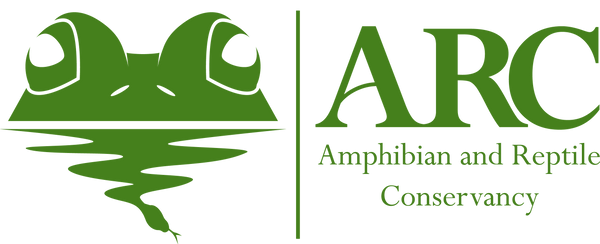Partners in Amphibian and Reptile Conservation (PARC) is an inclusive partnership dedicated to the conservation of the herpetofauna–reptiles and amphibians–and their habitats. Our membership includes individuals from state and federal agencies, conservation organizations, museums, pet trade industry, nature centers, zoos, energy industry, universities, herpetological organizations, research laboratories, forest industries, and environmental consultants. The diversity of our membership makes PARC the most comprehensive conservation effort ever undertaken for amphibians and reptiles.
Join our membership to help conserve reptiles, amphibians, and their habitats for current and future generations. Join Now!

Mission
Forging proactive partnerships to conserve amphibians, reptiles, and the places they live.
Vision
A society where amphibians and reptiles are valued for their importance in our natural and cultural heritage, and are considered in all conservation and land management decisions.
PARC is:
- A unique national and international conservation network that includes regional networks
- A diverse group of like-minded citizens, professionals, and organizations
- An open forum for discussing herpetofaunal conservation
- A resource for everyone who values herpetofauna and their habitats
- An advocate of inclusive reptile and amphibian conservation
Regions
PARC is organized into five officially recognized regional working groups that serve as the operating entities of the PARC network. Through this system, PARC can focus on national and regional herpetofaunal conservation challenges. Northeast (NEPARC), Southeast (SEPARC), Midwest (MWPARC), Southwest (SWPARC), and Northwest (NWPARC) working groups have been established to allow for specific communication within each region. The Department of Defense also has a PARC chapter, DoD PARC. In addition, at this time we officially recognize the following state chapters and subunits: Alabama, Colorado, Florida, Idaho, Michigan, North Carolina, Wisconsin, and the Caribbean.
Click HERE to find PARC in your area
PARC Organization and Contacts
Joint National Steering Committee (JNSC)
The JNSC is the leadership body of PARC, guides PARC activities, is intended to include a diversity of stakeholders, and shall consist of up to 26 seats with up to 17 voting representatives:
- Two (2) National co-chairs serving at-large (2 seats; 2 votes),
- Two (2) Regional co-chairs each from the five Regional Working Groups (RWG; 10 seats; 5 votes),
- The PARC Federal Agencies Steering Committee (FASC) co-chairs (2 seats; 1 vote),
- The Association of Fish and Wildlife Agencies (AFWA) Amphibian and Reptile Conservation Committee chair and vice-chair (2 seats; 1 vote),
- No more than three (3) at-large, non-agency members (at least 1 of which will represent the private sector), as appointed by the JNSC National co-chairs, and subject to approval by a majority vote of the voting body of the JNSC (up to 3 seats; 3 votes),
- The National Coordinators (2 seats; 2 votes),
- The Department of Defense (DoD) (2 seats; 1 vote),
- DEITT ExComm Rep and DEITT Co-Chair (3 seats, 2 votes).
Brad O’Hanlon: Senior Co-Chair
Reptile and Amphibian Conservation Coordinator; Florida Fish and Wildlife Conservation Commission
Melissa Youngquist: Junior Co-Chair
Research Biologist; Shedd Aquarium
Mark Mandica: DEITT Representative
Executive Director, The Amphibian Foundation
See the full list of JNSC members here. Contact parc_coordinators@parcplace.org for additional information.
Federal Agencies Steering Committee
The Federal Agencies Steering Committee, or FASC, is comprised of representatives from 12 federal agencies. The FASC operates under a Memorandum of Understanding, the purpose of which is to provide a framework for cooperation and coordination in achieving the objectives of the FASC , and in matters relating to the conservation of amphibians, reptiles, and their habitats.
Brad Jost: Senior Co-chair
Wildlife Biologist, Division of Wildlife Conservation, Aquatics, and Environmental Protection
US Bureau of Land Management, Headquarters
Amy Commens-Carson: Junior Co-chair
Southern Region Fisheries Program Manager
US Forest Service
Jenny Schultz: Ex-Officio Co-chair
Fishery Biologist, Endangered Species Division, National Marine Fisheries Service
Office of Protected Resources
State Agency Advisory Committee
The Association of Fish and Wildlife Agencies, a membership organization of all of the state and territorial fish and wildlife agencies in the US and Canada, hosts an Amphibian & Reptile Conservation Committee, which serves as the state agencies’ advisory committee to PARC.
David Golden: Chair
Assistant Commissioner
New Jersey Division of Fish and Wildlife
Becky Gwynn: Vice-chair
Executive Deputy Director
Virginia Department of Wildlife Resources
Federal Coordinator
Michelle R. Christman (she/her)
U.S. Fish & Wildlife Service
Natural Resource Program Center
Fort Collins, CO
State Coordinator
Kerry Wixted (she/her)
Amphibian, Reptile and Invasive Species Program Manager
Association of Fish & Wildlife Agencies
Washington DC
Website Administrator
Fiscal Sponsorship
The Amphibian and Reptile Conservancy (ARC) is the fiscal sponsor of PARC and helps provide funding to support our shared mission of herpetofaunal conservation. Therefore, another way to support PARC is to donate to ARC. If you want your donation to go to PARC, please make a note on your ARC donation form. The Amphibian and Reptile Conservancy is a 501(c)(3) nonprofit organization. You can find ARC’s Charity Navigator rating here.


